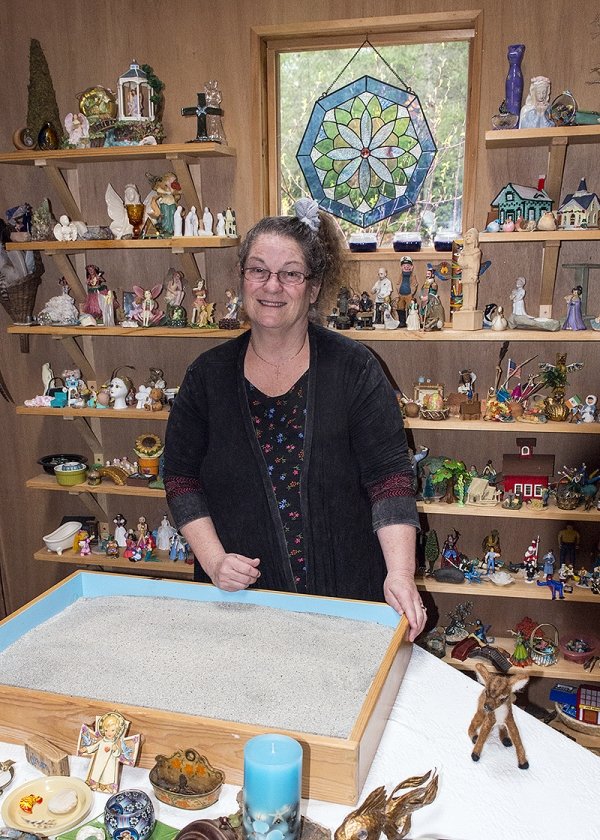Irene Torres
 Claudia Patchen in her Sandplay Therapy room. Photo by Ed Johnson, KP News.
Claudia Patchen in her Sandplay Therapy room. Photo by Ed Johnson, KP News.
Nearing completion of her master's degree in 2011, Claudia Patchen had been looking for an internship opportunity. An acquaintance, Daniel Thompson, from Olalla, suggested Jumping Mouse Children’s Center in Port Townsend. There she met Dott Kelly, who would become her mentor in Sandplay Therapy. Patchen made a commitment to commute two and a half hours every week from her home near Carney Lake to work with children ages 3 through 10. “That was the best experience of my life,” she said.
Patchen's degree is in pastoral counseling and she holds a certificate in social service/mental health counseling from Pierce College. She also interned in the acute assessments unit at Western State Hospital. "My training is very eclectic, but I really like depth psychology, finding the deeper meaning in things," she said.
“You can’t go into Sandplay Therapy with children and not be changed. It is especially good for children who have experienced trauma in their young lives. It is not directive. They create a story, or whatever experience they need to work out, in the sand tray. It is sacred space. When I say that, it doesn’t mean that I am religious. It is for people to get in touch with their beliefs, even if that is not believing,” said Patchen.
A regulation sandplay tray is a 24 by 30 inches and 3 to 4 inches deep. It is meant to reflect the world or the universe of the client. The quadrants of the tray represent heaven/spiritual, the Earth, family warmth and the unconscious. Patchen likened it to the Native American symbolism of the four directions.
Every collection of Sandplay figures is different. Clients are encouraged to let the figures "pick them."
“They go down into the unconscious, like dreaming in daylight, and pick symbols that will aid in the healing process. That sounds esoteric,” said Patchen,” but it is really deep healing.
“I think Carl Jung did it himself. He went on the 'hero’s journey' and discovered a lot about himself in the stones and sand on the river’s edge. Dora Kalff made it into a therapy,” Patchen said. The therapist observes, takes notes and photographs. “I pay attention to the energy. It’s about the process. And at the end, I save it in a book for them to take home,” she said.
Patchen quoted Clark Moustakas, “Play is the work of children.” And for adults with childlike hearts, she added, “Sandplay allows a way for them to heal and get strong in their core, to be able to survive. People are free to work out whatever it is that’s got them stuck, and know that it is confidential and safe.” She said her teachers compared her to Virginia Satir, a Systems Therapy expert. Her own mentor and therapist, Gretchen Hegeman, prominent in the organization Sandplay Therapists of America, told her, “You’ve been invested in. You have a gift. You need to use it."
Patchen prefers to take only one or two clients at a time, “because it takes a lot out of me.” She can access certified supervision when that is needed for a particular case. Her dream is to have a mobile Sandplay practice and travel to schools and social service agencies. She and her husband, Alan Kemp, have a "canned ham" travel trailer that she wants to "trick out" and take on the road to work with troubled youth. Until that happens, she is content to stay at home and write poetry.
For more information, contact Patchen at 253-468-6115.
 Claudia Patchen in her Sandplay Therapy room. Photo by Ed Johnson, KP News.
Nearing completion of her master's degree in 2011, Claudia Patchen had been looking for an internship opportunity. An acquaintance, Daniel Thompson, from Olalla, suggested Jumping Mouse Children’s Center in Port Townsend. There she met Dott Kelly, who would become her mentor in Sandplay Therapy. Patchen made a commitment to commute two and a half hours every week from her home near Carney Lake to work with children ages 3 through 10. “That was the best experience of my life,” she said.
Claudia Patchen in her Sandplay Therapy room. Photo by Ed Johnson, KP News.
Nearing completion of her master's degree in 2011, Claudia Patchen had been looking for an internship opportunity. An acquaintance, Daniel Thompson, from Olalla, suggested Jumping Mouse Children’s Center in Port Townsend. There she met Dott Kelly, who would become her mentor in Sandplay Therapy. Patchen made a commitment to commute two and a half hours every week from her home near Carney Lake to work with children ages 3 through 10. “That was the best experience of my life,” she said.